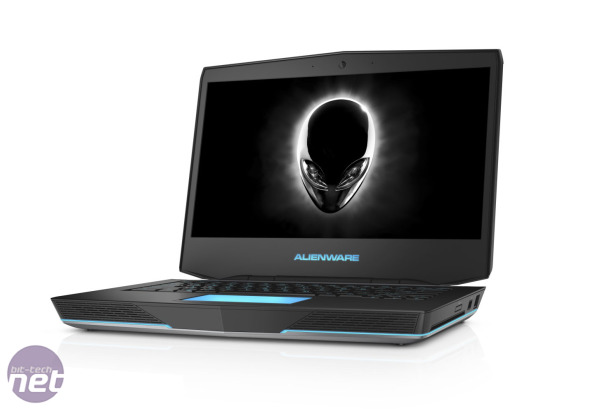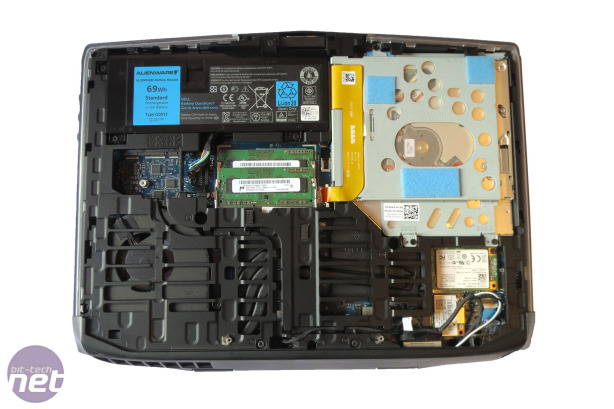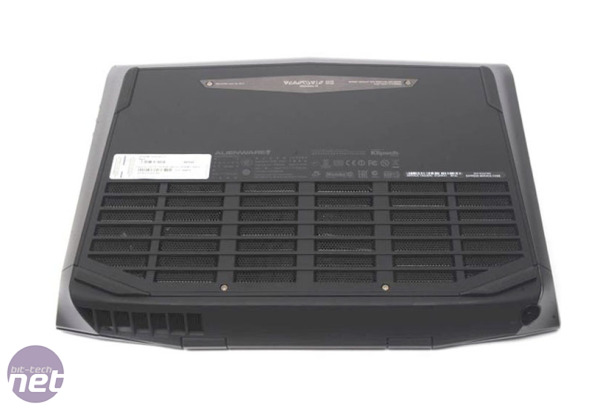
Alienware 14 Review - Features and Specs
One of the biggest advantages of the Alienware 14 over the various aforementioned laptops is that it does include an optical disc drive, specifically a slot-loading DVD drive (Blu-ray is also available for £99.99 extra). This is positioned on the right-hand side along with a card reader, USB 2.0 port and a Gigabit Ethernet connection, while the left-hand edge has two USB 3.0 sockets, HDMI and mini-DisplayPort outputs, and a trio of audio jacks. There is one omission, and that’s Thunderbolt. Although still largely associated with Apple, it’s actually a very useful and versatile connection that is becoming more common.Alienware isn’t known for providing for customer upgradability but here the base is made from one large removable panel, so several of the interior components can be accessed and altered. The two SO-DIMM slots are easy to reach, as are the mSATA SSD and half-height Wi-Fi cards. The 2.5in drive is rather more hidden, though, making it more of a laborious upgrade. The battery is replaceable, too, although it’s screwed in beneath the base panel so it can’t very easily be swapped out for a longer-lasting power pack when out about. Neither can the optical drive be swapped out for a bigger battery.
Like the P303 Pro, air for cooling the components is drawn in from under the Alienware 14, but here it's blown out the back, which we think is a slightly more sensible arrangement then the side vent of the P303. The grilles on the bottom are also much more extensive, and include raised ridges to help ensure at least some cold air gets in, even when some of the venting is covered. As a result is does run a little cooler and quieter than the P303 Pro.
Our machine is the middle of the three models Dell sells, and that means it centres around a Core i7-4700MQ processor. It’s the weakest of the parts from Intel’s mobile Haswell Core i7 range, but it’s a chip that can still pack a punch thanks to its four Hyper-Threaded cores and its stock speed of 2.4GHz that can Turbo Boost to hit a top speed of 3.4GHz.
The GeForce GTX 765M is one of Nvidia’s latest mobile GPUs, and it’s the same chip that’s used inside the XMG machine. It’s not Nvidia’s most powerful portable part, but it still comes with a formidable specification: 768 stream processors clocked to 850MHz alongside 2GB of 4,000MHz GDDR5 RAM. Only Nvidia’s Turbo mode is missing, and that means the GPU won’t dynamically overclock to faster speeds.
Elsewhere, there’s 8GB of DDR3 RAM, a 256GB LiteOn LMT-256M6M SSD, a 750GB hard disk and dual-band 802.11n Wi-Fi.
As usual, this Dell-made machine can be configured with a range of different components. The base model costs £949 inc VAT, but that means dropping down to a Haswell-based Core i5 processor, an Nvidia GT 750M processor, and a 1,366 x 768 screen – perhaps the biggest disappointment with this cheapest specification.
The top-end model, in contrast, costs a mighty £1,649 inc VAT (and that's just the base price). The pricier version includes a Core i7-4800MQ processor, 16GB of RAM and a Blu-ray drive – but still makes do with the mid-range GeForce GTX 765M graphics core. There’s evidently no room inside this smaller machine for the GTX 780M.
The three available models can be modified with several different components. Dropping down to a GeForce GT 750M graphics core saves £150, and fitting a 256GB mSATA SSD puts £250 onto the price. Doubling the memory costs an additional £150, and the top-end model can be fitted with a mighty 2.8GHz Core i7-4900MQ processor – an upgrade that adds £200 to your bill.
It’s not a bad selection, but the Schenker is even more customisable. You can choose from almost the complete range of compatible Intel CPUs, start with just 4GB of RAM and even leave out Wi-Fi and Bluetooth or pick from a selection of wireless cards, including future-proofed dual-band 802.11ac networking. You can also choose from different versions of Windows, with an option to leave it out altogether, and the base model costs just £663 – far cheaper than the most affordable Alienware 14.

MSI MPG Velox 100R Chassis Review
October 14 2021 | 15:04











Want to comment? Please log in.